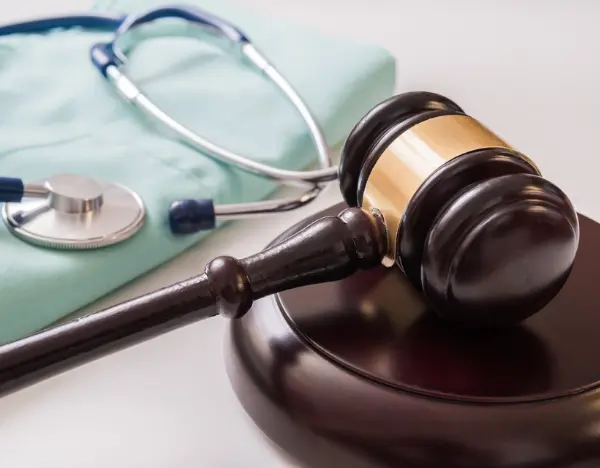How Does a Medical Malpractice Lawsuit Work?

At Rainsbury Law Group, we understand that dealing with medical malpractice can be a daunting experience. If you or a loved one has suffered due to medical negligence in Folsom, CA, you may be wondering, how does a medical malpractice lawsuit work? This guide is designed to provide you with a comprehensive overview of the process, helping you navigate the complexities of the legal system.
Working with Rainsbury Law Group means having a dedicated team by your side, ready to navigate the challenges of a medical malpractice lawsuit. If you believe you have been a victim of medical negligence, don’t hesitate to contact us for a consultation.
What is Medical Malpractice?
Before we dive into how a medical malpractice lawsuit works, what is medical malpractice? It refers to a situation in which a healthcare professional fails to provide the standard level of care expected in their field, resulting in harm to a patient. This breach can occur due to negligence, errors in judgment, or a failure to act appropriately under the circumstances. Understanding medical malpractice is essential for patients seeking justice and accountability for their injuries.
Key Elements of Medical Malpractice
To establish a case of medical malpractice, four key elements must be proven:
- Duty of Care:
-
- This refers to the legal obligation that a healthcare provider has to their patient. When a patient seeks treatment, a doctor or healthcare professional assumes a duty to provide appropriate care based on established medical standards.
- Breach of Duty:
-
- A breach occurs when the healthcare provider fails to meet the accepted standard of care. This could involve making a mistake during treatment, overlooking critical symptoms, or failing to follow established protocols. For instance, if a doctor fails to order necessary tests that could have diagnosed a serious condition, this may constitute a breach.
- Causation:
-
- This element requires demonstrating that the breach of duty directly caused the patient’s injury. It’s not enough to show that a healthcare provider made a mistake; you must also prove that this mistake led to specific harm. For example, if a delayed diagnosis of cancer results in a poorer prognosis, the link between the breach and the patient’s outcome must be clear.
- Damages:
-
- The final element involves showing that the patient suffered measurable harm. Damages can be physical, emotional, or financial. This might include medical expenses for additional treatment, lost wages due to inability to work, and compensation for pain and suffering.
Common Types of Medical Malpractice
Medical malpractice can manifest in various forms, and understanding these can help patients recognize when they have been wronged. Common types include:
- Surgical Errors:
-
- These may involve operating on the wrong body part, leaving surgical instruments inside a patient, or failing to adequately monitor a patient during surgery. Such errors can have serious, life-altering consequences.
- Misdiagnosis or Delayed Diagnosis:
-
- A crucial aspect of medical care is timely and accurate diagnosis. When a healthcare provider fails to correctly identify a condition, it can lead to a delay in necessary treatment, allowing the condition to worsen. For example, a missed diagnosis of a heart condition can have fatal consequences.
- Medication Errors:
-
- These occur when a patient receives the wrong medication, incorrect dosage, or inappropriate prescriptions. Such mistakes can result in severe adverse reactions and complicate the patient’s health further.
- Childbirth Injuries:
-
- Negligence during childbirth can result in serious injuries to both the mother and the child. This can include failure to monitor fetal distress or improper handling during delivery, leading to conditions like cerebral palsy or other long-term disabilities.
Local Context in Folsom, CA
In Folsom, CA, medical malpractice cases can arise in various healthcare settings, from small clinics to larger institutions like the Sutter Roseville Medical Center. Given the local population’s reliance on these facilities, understanding what constitutes medical malpractice is crucial for patients. If you or a loved one has experienced medical negligence, recognizing these issues can empower you to seek the justice you deserve.
Steps in a Medical Malpractice Lawsuit
1. Consultation with a Medical Malpractice Lawyer
Before proceeding with a lawsuit, it is essential to consult with a medical malpractice lawyer. At Rainsbury Law Group, we will assess your case, gather relevant details, and determine whether you have a valid claim. During this initial consultation, we will discuss:
- The specifics of your situation
- Possible medical negligence
- The likelihood of a successful claim
2. Gathering Evidence
After deciding to move forward, your lawyer will gather evidence to support your claim. This may include:
- Medical records
- Witness statements
- Expert testimonies from medical professionals
In Folsom, we often collaborate with local medical experts to strengthen our cases.
3. Filing the Complaint
Once sufficient evidence is gathered, your lawyer will file a formal complaint in the appropriate court. This document outlines your allegations and the damages you seek. It's crucial to file within the statute of limitations, which in California is generally three years from the date of injury or one year from when you discovered the injury.
4. Discovery Phase
The discovery phase involves both parties exchanging information relevant to the case. This can include:
- Interrogatories: Written questions that must be answered under oath.
- Depositions: Sworn testimony from witnesses or involved parties.
This phase can be lengthy, but it is essential for building a strong case.
5. Negotiation and Settlement
Many medical malpractice cases are settled before reaching trial. Your lawyer will negotiate with the defendant's insurance company to reach a fair settlement. Factors considered in these negotiations include:
- Medical expenses
- Lost wages
- Pain and suffering
If a fair settlement cannot be reached, your case will proceed to trial.
6. Trial
During the trial, both sides present their evidence and arguments before a judge or jury. The trial may take several days or weeks, depending on the complexity of the case. After deliberation, the jury will render a verdict.
7. Post-Trial Motions and Appeals
If you win your case, the defendant may file post-trial motions or appeals. Your lawyer will guide you through this process, ensuring that your rights are protected.
Key Considerations in a Medical Malpractice Lawsuit
When pursuing a medical malpractice lawsuit, several critical factors must be considered to build a successful case. Understanding these elements can help you navigate the complex legal landscape and advocate effectively for your rights.
Establishing Negligence
To succeed in a medical malpractice lawsuit, it is essential to prove that the healthcare provider acted negligently. This involves demonstrating four key components:
- Duty of Care:
-
- The first step is establishing that the healthcare provider had a legal obligation to care for you. This duty arises when you enter into a patient-provider relationship. For example, if you visit a doctor for treatment, that doctor is required to provide care that meets established medical standards.
- Breach of Duty:
-
- The next step is to show that the health care provider failed to meet the expected standard of care. This standard is often defined by what other qualified health care professionals would have done in similar circumstances. Factors influencing the standard of care can include the medical specialty of the provider and the specific circumstances of the case. For instance, a surgeon who makes a mistake during an operation may be found to have breached their duty if their actions fall below what a competent surgeon would have done.
- Causation:
-
- After establishing a breach of duty, you must demonstrate that this breach directly caused your injury. It is not enough to show that a healthcare provider was negligent; you must prove that their negligence resulted in tangible harm. This often involves complex medical evidence and expert testimony to establish a clear link between the health care provider’s actions and your injuries.
- Damages:
-
- Finally, you need to show that you suffered damages as a result of the negligence. Damages can take various forms, including physical injuries, emotional distress, and financial losses such as medical bills or lost wages. Documenting these damages is crucial, as they form the basis for any compensation you may seek.
Importance of Expert Testimony
Expert testimony is a cornerstone of medical malpractice cases. Qualified medical professionals provide critical insights into the standard of care and how the defendant deviated from it. This testimony can clarify complex medical issues for the court and help establish whether negligence occurred.
- Defining the Standard of Care: Experts can explain what is generally accepted as appropriate treatment for specific medical conditions, helping to establish a baseline for comparison.
- Analyzing the Breach: They can assess whether the healthcare provider's actions fell short of this standard, providing an objective viewpoint that is essential in court.
At Rainsbury Law Group, we collaborate with reputable experts who can strengthen your case. Their input can be invaluable in persuading a jury or judge about the merits of your claim.
The Role of Insurance Companies
Insurance companies play a significant role in medical malpractice cases. They typically represent healthcare providers and are responsible for settling claims or defending against lawsuits. Understanding their role is crucial for navigating the legal process effectively.
- Claims Evaluation: Insurance companies will evaluate claims to determine their validity and the extent of liability. They may conduct their investigations, which can include reviewing medical records and interviewing expert witnesses.
- Minimizing Payouts: Insurance companies often aim to minimize their financial exposure. This can result in low settlement offers or attempts to deny claims altogether. They may argue that the medical provider acted within the standard of care or that your injuries were not a direct result of the provider's actions.
- Negotiation Strategies: Having a skilled medical malpractice lawyer can make a significant difference in negotiations with insurance companies. Your lawyer can advocate for fair compensation, counter low offers, and provide evidence that supports your claim. They can also help you understand your rights and the implications of any offer made by the insurance company.
Understanding the key considerations in a medical malpractice lawsuit is essential for anyone who believes they have been a victim of medical negligence. Establishing negligence involves proving duty of care, breach of duty, causation, and damages. Expert testimony is critical in clarifying complex medical issues, while navigating the role of insurance companies can be challenging without legal support. At Rainsbury Law Group, we are dedicated to guiding you through this process, ensuring that your rights are protected and that you receive the compensation you deserve. If you have questions or need assistance with a potential claim, don’t hesitate to reach out for a consultation.
What Kind of Compensatory Damages Can the Plaintiff Receive?
In a medical malpractice lawsuit, plaintiffs may be entitled to various types of damages, depending on the nature of their injuries and the impact on their lives. Understanding the different categories of compensatory damages can help you assess the potential compensation available for your case.
1. Economic Damages
Economic damages are quantifiable losses that can be calculated and documented. They often include:
- Medical Expenses: This includes all costs related to medical treatment required due to the malpractice. It can cover hospital stays, surgeries, medications, rehabilitation, and any future medical care needed.
- Lost Wages: If your injuries prevent you from working, you may be compensated for lost income during your recovery. This can include past and future earnings if your ability to work is permanently affected.
- Property Loss: In some cases, damages may also cover the loss of property, such as medical equipment or other items impacted by the malpractice.
2. Non-Economic Damages
Non-economic damages refer to subjective losses that are not easily quantifiable. These may include:
- Pain and Suffering: Compensation for physical pain and emotional distress resulting from the malpractice. This can encompass both the immediate suffering and long-term effects on quality of life.
- Emotional Distress: This includes psychological impacts such as anxiety, depression, or loss of enjoyment of life due to the injuries sustained.
- Loss of Consortium: If the malpractice affects your relationship with a spouse or partner, you may be entitled to damages for loss of companionship, affection, and intimacy.
3. Punitive Damages
In some cases, plaintiffs may be awarded punitive damages. These are not intended to compensate the plaintiff directly but are meant to punish the defendant for particularly reckless or egregious behavior. Punitive damages serve as a deterrent, aiming to prevent similar conduct in the future.
Working with Rainsbury Medical Malpractice Lawyers
Navigating a medical malpractice lawsuit can be a complex and emotionally challenging process. At Rainsbury Law Group, we are dedicated to providing you with the guidance and support you need every step of the way. Here’s what you can expect when working with our team of experienced medical malpractice lawyers.
Personalized Consultation
Your journey begins with a personalized consultation. During this meeting, we will:
- Listen to Your Story: We take the time to understand your unique situation, including the details of your medical care and the impact it has had on your life.
- Assess Your Case: Our lawyers will evaluate the merits of your medical malpractice claim, helping you understand whether you have a valid case of medical malpractice.
Comprehensive Case Preparation
Once you decide to move forward, we will work diligently to prepare your case. This includes:
- Gathering Evidence: We will collect medical records, witness statements, and any other relevant documentation to support your medical malpractice claim.
- Consulting Experts: Our team collaborates with medical experts who can provide critical insights into the standard of care and how it was breached in your case.
Strong Advocacy
Throughout the legal process, we will be your advocates. This involves:
- Negotiating with Insurance Companies: We will handle all communications with insurance providers, ensuring that your interests are prioritized and that you receive a fair settlement.
- Representing You in Court: If your case goes to jury trial, our skilled lawyers will represent you in court, presenting a compelling case to support your medical malpractice claim.
Ongoing Support
At Rainsbury Law Group, we believe in providing continuous support to our clients. We will keep you informed throughout the process, answering any questions you may have and addressing your concerns. Our goal is to make the legal experience as smooth as possible for you.
Commitment to Justice
We are committed to fighting for your rights and ensuring that you receive the compensation you deserve for your injuries. Our team understands the complexities of medical malpractice law and is dedicated to holding negligent parties accountable.
Working with Rainsbury Law Group means having a dedicated team by your side, ready to navigate the challenges of a medical malpractice lawsuit. If you believe you have been a victim of medical negligence, don’t hesitate to contact us for a consultation. Together, we can work toward achieving justice and securing the compensation you need to move forward with your life.

